The 4 Foundations of Fire and Extinguishment
1/21/2022 (Permalink)
 If your home or business has any damage, SERVPRO of Putnam County is ready around the clock to help you recover.
If your home or business has any damage, SERVPRO of Putnam County is ready around the clock to help you recover.
If you happen to recall the tetrahedron shape from geometry class, you’ll remember that it’s a three-dimensional triangle shape with four triangular faces. You had it—we know you did.
If you’re wondering why we brought it up, it’s because we want to introduce you to something called the fire tetrahedron, which is a shape scientists use to represent the four things fires need to start and survive.
These things are all equally important, and without a single one of them, fires can’t start—which gives us insight also into how fires can be extinguished.
Fuel. This is what will burn; it’s what will actually be ignited. Sources like wood or dry leaves, or any number of organic or inorganic materials, will do.
Heat. Almost every substance has a heat threshold, above which it becomes unstable and ready to burst into flame.
Oxygen. Fires, like humans, require oxygen to keep going. Oxygen fuels the fourth part of the tetrahedron, which is the…
Chemical Chain Reaction. The oxygen in combination with the other elements creates a chain reaction, which will continue until something enters the fray to put a stop to it.
Speaking of stopping it…
Cool it. When you think of putting out a fire, this is likely what your first instinct is. Cooling a fire with water is one of the most common techniques. Water can be used to quickly cool a fire’s fuel source to a temperature that won’t allow it to continue to combust. Cooling the burning element to a thermal balance means it reaches a point at which heat can’t be generated fast enough to overcome the cooling process. The larger the fire, the more water will be required, in part because some of it will sublimate.
Smother it. If a fire is deprived of oxygen, it can’t continue to grow. Smothering a fire with a thick substance that separates it from the air around it is an effective stoppage method. This can be done with something like a fire blanket, but it can also be accomplished with other methods, as we’ll see in a moment.
Starve it. Simply put, if a fire runs out of material to consume, it stops. This is why wildfires are often contained by intentionally burning an area around them, to keep them from gaining further ground.
Interrupt the chain reaction. Certain chemicals and gases can be introduced into a fire to disrupt the reaction that keeps it going. Halon in particular is very good at this, but because of its negative effect on the ozone layer,, it is no longer being produced. The remaining store, however, is allowed to be used, and it often is, in places where using water would damage electrical equipment.
If the fire tetrahedron makes a wreck of your home or business, we’re ready around the clock to help you recover. Contact SERVPRO anytime for fast, thorough cleanup and recovery after a fire.






 24/7 Emergency Service
24/7 Emergency Service